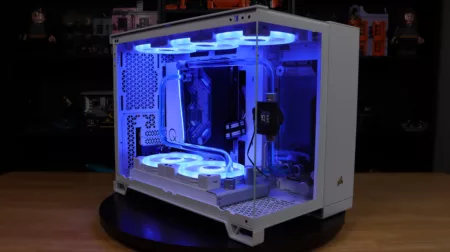With the curtain finally raised, it’s time for AMD’s new processor to take center-stage what with all the noise in the motherboard scene being all about Intel. AMD is set to take on the market again with its new APUs and we have a couple of boards to test out this new offering for the new FM2 socket. There’s going to be a lot of releases for this new line of processors and one of the first one out of the gates is GIGABYTE and they’ve sent us their own performance FM2 board, the F2A85X-UP4. Also in for the ride is the Trinity-based A10-5800K, the current flagship of AMD’s APU line based on the Piledriver architecture. If you’re looking for a lecture on this new processor architecture, you won’t find it here. We’ll be looking at a purely performance perspective in this review and we’ll leave the text book material to the other guys. Let’s get started and let’s make this extremely showy!
GIGABYTE has been on a roll lately, rolling out product after product in the motherboard market but the majority of which are all Intel 7-series based. Now AMD is back, and a lot of board makers will definitely be jumping in to provide their own offerings in this segment and we expect GIGABYTE to put out some decked out products as we’ve seen them do for so many times. Like we’ve mentioned earlier, we’ll be limiting our review to a purely performance scope that will cover our usual computation benches all the way to gaming figures which should be the most important aspect of this new architecture.
Check out the specs at the product page here.
PHOTO GALLERY
Check out our gallery of the GIGABYTE F2A85X-UP4 in our gallery section by click this LINK.
TEST SETUP & OVERCLOCKING
Processor: AMD A10-5800K APU
Motherboard: Gigabyte GA-F2A85X-UP4
Memory:Â Kingston HyperX Predator DDR3-2400 8GB Dual-Channel Kit (running at 2133)
Storage:Â Kingston HyperX SSD 120GB
PSU:Â Silverstone Strider Plus 650W ST65F-P
Cooling:Â Corsair H80
As we’ve never previously tested any FM1 system before we find it more relevant to include more current offerings out in the market for comparison hence we will be comparing results between the Core i7-3770K and its HD4000 graphics engine and a nVidia Geforce GT620 from MSI for entry-level comparison. Do note that computational results are purely for reference due to the segment difference of both products.
So here we have the new Trinity APU from AMD. Basically the A10-5800K we got is a modified FX-4110 that got married to a 7660D so overclocking should be the same for both but the one roadblock here is heat since the GPU and CPU exist in one package. For those not familiar, the APU or Accelerated Processing Unit is AMD’s solution to people who need decent integrated graphics for mostly entertainment and office use. Motherboard makers though expand on that idea by providing motherboards with features that cater to budget-conscious gamers and multimedia enthusiasts. GIGABYTE has integrated their signature features in the F2A85X-UP4 which goes to show they are not favoring the Intel camp.
Moving on to overclocking, we’re back in GIGABYTE’s 3D BIOS which we surely do feel at home at. APU’s in general start to choke at x44 multiplier and as expected our sample hit a wall at that range. We could take the board to x46 to the OS but it’s quite unstable. Jumping towards the GPU department, we bumped our GPU to 1000Mhz from the stock 800Mhz giving us a nice boost in 3DMark 11 score. We did hit a snag on the memory departments, hitting instabilities when running DDR3-2400. Our DIMMs have Profiles for 2400 and 2133 but the BIOS locks us at 2133 for both. All other values are kept. As an early release BIOS, we feel this would be corrected in a future BIOS update as GPU performance should scale quite well with increased memory bandwidth.
EDIT: A newer BIOS revision has provided us with further features for individually configuring XMP and AMP profiles.
PERFORMANCE
SiSoft’s SANDRA is a benchmarking, testing and system information application which provides plenty of options in gaining information regarding your system. For this test, we gauge the raw computational power of the CPU with the Processor Arithmetic benchmark based on the Whetstone and Dhrystone test. Both tests run completely within the processor so it gives a good picture of how a processor performs.
As we’ve mentioned earlier, we present these date for reference and not as a direct comparative of the processors. That said, the majority of the computational tests will see the APU drag behind the Ivy Bridge system. We will upgrade this section in the future once we get more FM2 boards added in our tests archive. For now do bear with us and we will keep the commentary thin as well and leave the graphs to your conclusion.
wPrime is a multi-threaded benchmarking application designed to measure the raw computational power of a CPU. It can be configured to run on a custom number of threads to accomodate multi-core CPUs.
Maxon offers a nice benchmark tool called Cinebench which really stresses your entire system to render a very complex scene. The output score is completely unique to Cinebench but allows us to have a rough idea of how the CPU works with 3D rendering tasks.
SuperPI is another benchmarking tool that utilizes the pure computational power of a CPU. This test however is purely single-threaded and shows us the performance of a single core which gives us a good picture of how a processor performs on similar tasks.
3D Mark06 is a benchmarking software designed to measure the performance of a system in DirectX9 applications. The test has long been updated with newer version of the software for more modern use but results are still relevant.
3DMark Vantage is the successor to 3DMark 06 and is targeted for DirectX10 compliant devices. Performance test was used for this test.
WORKLOAD TESTS
We use a 150MB 1080p MP4 video and convert it to standard iOS format using Xilisoft Video Converter. GPU acceleration is disabled and conversion is purely done by the CPU.
We convert a 73-minute album (D-Coy – Black Katipunero) into MP3 LAME 160Kbps CBR with dbPowerAmp Batch converter and note the time it takes to rip the disc.
We use WinRAR 4.0 on default settings to compress 3340 files of varying types including MP3s, various images and documents for a total of 2.40GB of data.
We resize 3,030 varying images of different formatsand sizes (a total of 883MB) to our standard 1200×900 resolution and note the time it takes to finish up the batch job.
X264 HDÂ is a free benchmarking tool that shows the performance of a system by converting a 720p video clip.
3D TESTS
Ungine’s Heaven benchmark is a DirectX application designed to measure the performance of a system in game-like loads.
3DMark 11 is the most recent iteration (not counting the version for the upcoming Windows 8) of the popular benchmarking software from Futuremark. For this test we run the Performance preset of the benchmark which comes with the free version of 3DMark 11 which should present a more reproducible scenario for a lot of people.
For some reason, 3DMark 11 keeps crashing on us everything the combined tests load. We’ll track the error down but due to time constraints we have decided to push through without the requisite data. As the benchmark itself is CPU and GPU dependent, we expect the APU to prove superior in this test though.
The benchmark modes in Civilization5 are designed to stress and test various aspects of the users hardware and supporting software. This benchmark is designed to simulate a late game workload as it exercises all aspects of the game engine pipeline since all simulation and renderable object types are represented at a frequency consistent with a game that has been in progress for 300+ turns. We capture the full render score for our comparison graphs.
Video Playback
Here’s the system CPU load during HD video playback.
GAMING EXPERIENCE
We put the A10-5800K along with the GA-F2A85X-UP4 to a gauntlet of real games testing along with the competing onboard solutions. We stuck with fairly high settings for the majority of our games except Battlefield 3 as we felt this should the situation where most gamers would want their games at. Lowering the settings should be up to them and performance increase should present itself afterwards.
A playthrough of the first level from the opening transfer of the NanoSuit to Alcatraz.
Linear mashing of Ratlins in Act I until after you enter the gates for the map shift.
Down The Rabbit Hole Level Playthrough.
From opening scene with Claptrap up to death of Knuckle Dragger.
Operation Flytrap playthrough.
HotLap Gauntlet – Miami Circuit with Lamborghini Aventador Full Race
Operation SwordBreaker playthrough up to after trace wire objective.
For the most parts of our tests, we saw some sub-30FPS scores which should shun a lot of “gamers” but do consider the fact that all of the scores we got from the APU were pretty solid. We had to point out that testing the Intel HD4000 and GT620 on max settings at 1920×1080 resolution was quite the challenge as they were, for a lack of a better word, seizure-inducing. The A10-5800K and its HD7660D managed to up our games to some quality FPS levels which made games smoother. One thing worth noting also is the detail that the HD4000 have which simply isn’t DX11 material. That said, we really like what we’re seeing from the APU right here. The GIGABYTE F2A85X-UP4 did a good job bringing out these numbers out of the A10.
TEMPERATURE & POWER CONSUMPTION
Sticking with the default BIOS options, we see how much power and how hot our systems get using the provided values of the manufacturer to see how aggressive or conservative they are in configuring their BIOS for consumer use. We load the system with OCCTPT to generate load and wattage measurement is taken from the socket. Do note that these are peak values.
With our system fully loaded, the FM2 platform along with the GIGABYTE motherboard eats up 172W of power off the outlet and idles at around 57.9W putting the idle consumption below Intel’s. Intel however has the advantage in load consumption but with a pretty weak GPU, the additional consumption is reasonable for the FM2.
CONCLUSION
We really have to hand it to GIGABYTE for creating a classy product for the APU market. Looking at this board, it’s certainly oozing of quality from the matte PCB all the way to the heatsinks and slots. Similar to the Z77X-UD3H we’ve checked out in the past that’s intended for people seeking pure performance and the essentials, the GIGABYTE F2A85X-UP4 brings to the table the full array of features we’ve come to expect from the board maker. We’ll highlight the Dual BIOS feature the most here since it really came in handy in our situation. After two failed BIOS updates due to the power outage, the board managed to revive itself. I really felt I was going to have to report a brick to GIGABYTE but that Dual BIOS really kicked in and saved us. Due to this we are giving GIGABYTE much love for creating an effective recovery system.
The GIGABYTE F2A85X-UP4 will retail at an estimated Php5650 which puts it a very convenient spot for users aiming for an APU build. We expect a wave of FM2 boards to hit the shelves soon , even from GIGABYTE itself, which should drive the cost down eventually but as with any performance offering from GIGABYTE, this board boasts features that scales with their users with a low cost of ownership. Backed by a 3-year warranty, we’re surely getting our money’s worth with this one if ever you do go down this route.
So in closing, the F2A85X-UP4 managed to bring out some punch from the A10-5800K from AMD, easily whooping the Intel HD4000 and nVidia GT620 in our gaming experience tests. Judging mostly from an FM2 platform adopter’s standpoint, there’s really nothing you can ask more from the board. All the essentials are there coupled with extra features like onboard buttons and that Dual BIOS feature that really saved our skin. Barring early BIOS issues, we feel that GA-F2A85X-UP4 by GIGABYTE is quite a solid product offering stability and performance and for that we give it our Performance Award.






3 Comments
check unigine heaven chart… is it labeled wrong, should it be higher is better?
Thanks for pointing that out, man. Will have the graphs corrected soon! Thanks!
Freakin’ awesome chip, and mobo combination. Now we wait for the competitors. 🙂